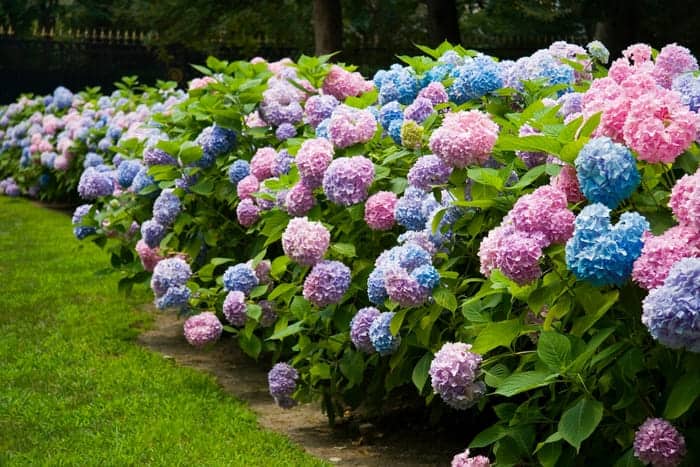Hydrangeas have always been one of the favorite flowers to grow around the house. Simply because hydrangeas have large flowers with vibrant colors such as red, pink, purple, blue…
The beauty of this flower always makes us admire and admire it for a long time. Therefore, hydrangeas are ranked among the most sought-after flowers in recent years.
For any type of flower, care will be important to match the unique characteristics of each type. One of the questions that many people are interested in recently is the pruning of hydrangeas.
Is pruning really necessary for hydrangeas? Will hydrangeas grow back if cut down? To answer this question, we need to take a closer look at the types of hydrangeas and their characteristics and decide whether to prune them.
6 Main Types Of Hydrangeas
Different types of hydrangeas will require different pruning times, so if you don’t have a basic knowledge of the type of hydrangea you’re growing, you may not be able to get vibrant blooms on the next crop.

Pruning for hydrangeas will depend on each variety and their characteristics, so you should first determine what type of hydrangea you grow to plan and take good care of.
Below, we will list the 6 most popular types of hydrangeas in the United States and are loved by many people who choose and care for them.
- Hydrangea macrophylla is a hydrangea native to Japan that grows up to 7 feet tall and 8 feet wide. Macrophylla hydrangeas are blue, red, pink, light purple, or dark purple. The color of this variety of hydrangea is influenced by the pH of the soil. Acidic soils (pH below 7) will usually produce flower colors close to blue, while alkaline soils (pH above 7) will produce pink flowers.
- Hydrangea macrophylla var. normalis is a large flower, inside are small clusters of flowers and the outside are covered with large flowers. Their color can be white, blue, pink, or purple.
- Hydrangea macrophylla subsp. Serrata is a flower native to the mountainous regions of Korea and Japan. They are usually about 4 feet tall, with oval leaves, and flowers that are blue and pink in the summer and fall.
- Hydrangea paniculata is native to southern and eastern China, Korea, Japan, and Russia. This plant prefers to grow in open forests, valleys, or on mountain slopes. The plant has oval leaves and conical flowers with white or green in late summer.
- Hydrangea quercifolia, also known as oak leaf hydrangea. It is native to the southeastern United States, in forests from western North Carolina to Tennessee, and south to Florida and Louisiana. It is a deciduous shrub with showy white flowers.
- Hydrangea arborescens is also a common flower native to the eastern United States. It is small to a medium-sized deciduous shrub that grows to 10 feet tall, and the flowers are brightly colored.
Will Hydrangeas Grow Back If Cut Down?
The 6 types of hydrangeas above are divided into 2 main groups: those that bloom on the old stem and those that bloom on the new stem.
Old stems are branches that were developed before the current season, and new stems are branches that are growing in the current season.
Therefore, this distinction is very important in pruning hydrangeas after each crop to ensure that the plant will bloom brilliantly in the following seasons.
Popular types of hydrangea – Hydrangea macrophyllas such as mophead, bigleaf, and rencap are varieties that can flower on older stems.
If you’re growing them in a temperate climate, you don’t need to prune them to stimulate leaf and flower growth the next season as they will continue to flower from the old stems from the previous crop.
However, if the pruning is to help reduce the size of the bush, it can be done within a few weeks immediately after the hydrangea has flowered. Pruning branches and leaves in late summer gives the tree time to develop buds for next summer’s blooms.
Also, the rest of the hydrangeas have new-stem flowering properties, so you may feel more comfortable pruning the old ones to let the plants focus their energy on growing new ones and flowering.
You should prune these hydrangeas in the fall or winter, even if you prune them to the ground, they will continue to grow again and flower next spring.
However, you should be aware that pruning branches close to the ground will weaken the trunk, so it’s a good idea to stake or have a plan in place to protect the young branches that are growing against the negative effects of weather in winters such as snow, high wind, storm or rain.
Summary
The pruning of hydrangeas depends on the variety that blooms on the old or new stem to continue doing. For hydrangeas that flower on old stems, you only need to prune broken branches, and yellow leaves to reduce the size of the bush as well as focus energy on healthy branches to flower.
For hydrangea varieties that flower on new stems, you can feel free to prune the old branches, but you need to make sure the bush is healthy and has large branches to support in windy or heavy rain.
If you are looking to learn more information about how to grow and care for this type of hydrangea, do not forget to join us for more references in the articles below.